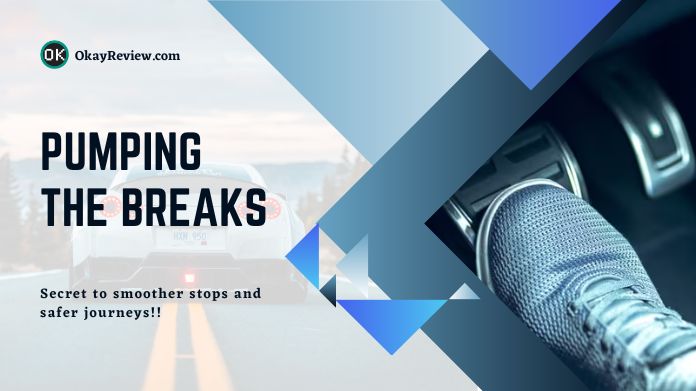Have you ever found yourself cruising down the road when suddenly, you need to hit the brakes hard? In that moments, pumping brakes will keep you safe.
Pumping brakes are commonly employed in non-ABS (Anti-lock Braking System) vehicles when the wheels lock up on slick terrains such as ice, snow, gravel, or wet roads.
In such situations, slamming on the brakes might cause the tires to lose grip, causing your automobile to slide uncontrollably. But don’t worry fellow drivers; applying the brakes will rescue the day!
Let’s explore why we need this skill and how it can make a real difference in those challenging moments behind the wheel with Okayreview.
Table of Contents
What Are Pumping Brakes Mean?
Pumping brakes is a driving method that involves the quick and repetitive application and release of brakes to slow or stop a vehicle, which is most commonly utilized on slick or low-traction roads.
Driving on wet roads, ice spots, or loose gravel is convenient for cars without ABS (traditional brakes).
Understanding this method is critical for safe driving since it allows drivers to control steering when decelerating in difficult situations.
It reduces accidents by preventing wheel lock-up and sliding. Mastering this technique in various scenarios, like winter driving, off-road conditions, or emergency stops, empowers drivers to maintain control and avoid obstructions for safer travels.
Why Do We Need to Pump the Brakes?
Pumping brakes are an essential driving technique with several crucial benefits:
1. Preventing Skidding and Loss of Control
To avoid wheel lock-up during harsh braking, this approach requires a fast and repetitive application and release of the brakes.
It helps drivers keep control of their cars by avoiding sliding, making steering easier, and lowering the danger of an accident.
2. Effectiveness in Adverse Weather Conditions
Pumping brakes are especially useful in tricky situations like wet or snowy roads.
It keeps traction by reducing wheel lock-up, providing drivers more control over their cars, especially in bad weather.
3. Avoiding Accidents and Collisions
Mastering the pumping brakes method allows drivers to manage emergency braking circumstances properly.
It enables users to maintain steering control while decelerating, assisting them in steering away from road obstructions and possible hazards, thus reducing accidents and crashes.
How to Pump the Brakes Effectively in Non-ABS Cars?
Correctly pumping brakes is a strategy used in non-ABS (Anti-lock Braking System) vehicles to prevent skidding while braking forcefully on slick or uneven ground.
Here’s a step-by-step tutorial to correctly pumping brakes:
Step 1: When stopping fast on slippery terrains such as ice, snow, gravel, or wet roads, non-ABS vehicles must pump the brakes to avoid wheel lock-up and sliding.
Step 2: If you come across a slick area and need to slow down or stop, apply the brakes firmly by squeezing the brake pedal with your foot.
Step 3: After applying the brakes, remove your foot from the pedal to relieve the pressure on the brake pedal.
Step 4: After releasing the brake pedal, immediately and firmly restore pressure with your foot to the pedal.
Step 5: Repeat the procedure of rapidly pushing and releasing the brake pedal as if you were “pumping” the brakes. The objective is to avoid continually depressing the brake pedal to keep the wheels from locking up and losing traction.
Step 6: Maintain control of the vehicle by keeping both hands on the steering wheel while pressing the brakes. While slowing down, concentrate on steering carefully.
How to Pump the Brakes Effectively in ABS Cars?
Pumping brakes in an ABS-equipped car, like Tesla cars, differ drastically from those in a non-ABS vehicle. ABS is intended to aid in the prevention of wheel locking during emergency braking, allowing the driver to maintain control.
Follow these instructions to pump the brakes in an ABS-equipped vehicle properly,
Step 1: Recognise the requirement to brake. Determine if the vehicle should be slowed or stopped. Maintain a safe distance from any obstruction or vehicle in front of you.
Step 2: Maintain constant pressure on the brake pedal. Place your foot firmly on the brake pedal. Apply consistent and constant pressure while avoiding slamming on the brakes.
Step 3: Let ABS do its work. It will activate if the ABS senses that any of the wheels are about to lock up when you apply the brakes. The device will rapidly pulse the brakes on and off to prevent skidding.
Step 4: Do not manually pump the brakes. Unlike in a non-ABS vehicle, you should not manually pump the brakes in an ABS vehicle. Pumping brakes can interfere with the operation of the ABS system and impair its efficiency.
Step 5: Keep steering control. Keep both hands on the steering wheel and direct the car from any possible risks or impediments when the ABS is engaged.
Wrap Up!!
When it comes to keeping our safety on the road, this strategy has the potential to be game-changing.
We may prevent disastrous skids and maintain control even in difficult driving situations if we understand how to pump the brakes function and practice using them correctly.
So, strap up, watch our brakes, and confidently traverse any road with this crucial driving knowledge!
Happy and safe driving, everyone!

